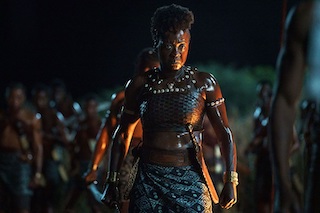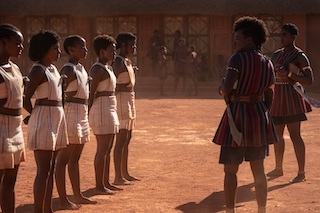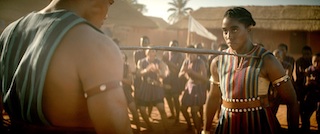 The Woman King, the critically acclaimed film from TriStar Pictures, Entertainment One and director Gina Prince-Bythewood, presents the remarkable story of the Agojie, an all-female unit of warriors who protected the African Kingdom of Dahomey in the 1800s with skills and a fierceness unlike anything the world has ever seen. Inspired by true events, The Woman King follows the emotionally epic journey of General Nanisca (Oscar-winner Viola Davis) as she trains the next generation of recruits and readies them for battle against an enemy determined to destroy their way of life.
The Woman King, the critically acclaimed film from TriStar Pictures, Entertainment One and director Gina Prince-Bythewood, presents the remarkable story of the Agojie, an all-female unit of warriors who protected the African Kingdom of Dahomey in the 1800s with skills and a fierceness unlike anything the world has ever seen. Inspired by true events, The Woman King follows the emotionally epic journey of General Nanisca (Oscar-winner Viola Davis) as she trains the next generation of recruits and readies them for battle against an enemy determined to destroy their way of life.
The film’s veteran sound team from Sony Pictures Post Production Services played a crucial role in bringing the Kingdom of Dahomey to full and vibrant life. Led by Academy Award-nominated supervising sound editor Becky Sullivan, the crew was tasked with creating meticulously detailed and historically accurate soundscapes to support sumptuous palaces, isolated villages, lush forests, breathtaking savannahs, and thrilling battles.
As few photographs and no sound recordings exist of historical Dahomey, Sullivan and her crew had to undertake deep research into the area’s flora, fauna. and human features before beginning their work. “We built a world of sound, the world of the Agojie, King Ghezo and his palace, and areas outside the city,” says Sullivan. “It’s an atmosphere of birds, bugs, and bare feet on earth. Every scene in this film is well-crafted, beautifully shot and skillfully edited. The sound had to achieve the same level of excellence.”
 Sullivan and her team collected recordings of elephants, lions, jackals, civets, and other mammals common to West Africa, dozens of bird species (weavers, cuckoo and Guinea fowl) and even bugs like mosquitos and tsetse flies. They also studied the area’s characteristic tree and plant life to accurately recreate the ambience of the film’s diverse locales. “We put a lot of time into those beautiful atmospherics,” she recalls.
Sullivan and her team collected recordings of elephants, lions, jackals, civets, and other mammals common to West Africa, dozens of bird species (weavers, cuckoo and Guinea fowl) and even bugs like mosquitos and tsetse flies. They also studied the area’s characteristic tree and plant life to accurately recreate the ambience of the film’s diverse locales. “We put a lot of time into those beautiful atmospherics,” she recalls.
Battles were especially challenging for the sound team. “Gina Prince-Bythewood wanted to hear the warriors fighting in an organic way,” Sullivan relates. “Our job was to add realism. A machete and a sword make different sounds. A machete has a thicker, darker, deeper metallic sound than a sword, which is thin and high-pitched. Other warriors carry spears with iron tips or knives, rope, or chains. Each one was crafted individually to get the sound right and make sure all were distinct.”
The Agojie prepare for battle by engaging in a ritual dance with scores of barefoot warriors swinging their weapons and moving in unison to the urgent rhythm of drums. “The women’s bodies are covered in oil, and they are beating their chests and singing,” Sullivan explains. “We had to replace the sounds of prop weapons with sound effects for the machetes while preserving the warriors’ voices from the production tracks. Weaving it all together and folding it into a beautifully edited montage was very challenging.”
 The film’s more intimate scenes required less intensive sound treatments, but for Sullivan they were very rewarding. “The scene with Nanisca and Nawi in the bathing caves was very emotional for me,” she relates. “A sonic landscape acts as an emotional bridge that takes the audience on a journey along with the characters. That scene covers a range of emotions: bravery, family, and loneliness. It’s beautiful.”
The film’s more intimate scenes required less intensive sound treatments, but for Sullivan they were very rewarding. “The scene with Nanisca and Nawi in the bathing caves was very emotional for me,” she relates. “A sonic landscape acts as an emotional bridge that takes the audience on a journey along with the characters. That scene covers a range of emotions: bravery, family, and loneliness. It’s beautiful.”
Sullivan accomplished all this with a small, tightknit crew. They included sound editors Jay Wilkinson, Hector Gika and Robert Troy, and assistant sound editor David Stanke. Foley sound was produced by Post Creations.
Mixing was accomplished in Sony Pictures’ 344-seat Cary Grant Theater by re-recording mixers Kevin O’Connell and Tony Lamberti and mix tech Kyle Artz. The final mix seamlessly blends sound effects prepared by Sullivan and her team, dialogue and a powerful, orchestral score composed by Oscar-nominee and six-time Grammy winner Terence Blanchard.
Sullivan describes the mix sessions as lively and collaborative and points to a scene near the film’s climax to illustrate how the sound elements work together to support the picture and help drive the narrative. “It’s an eight-minute sequence that begins with the battle dance and leads furious combat,” she notes. “There was a lot of close fighting supported by dialogue, sound effects and Terrence’s beautiful score. At the climax of the sequence, Nawi uses her masterful skills in wielding a rope as a weapon take out her enemies. At that moment, we take out the music so that all you hear is the whoosh, whoosh of her rope. It’s awesome.”
Sullivan says that she is immensely proud of the contribution she and her crew made to the film. “We had a tight schedule, the work was all consuming, and I absolutely loved it,” she says. “Watching and hearing it on the mix stage, I was continually impressed with how beautiful it was, and how important its message. Collaborating with Gina Prince-Bythewood and picture editor Teri Shropshire was a lovely experience, a highlight of my career.”
